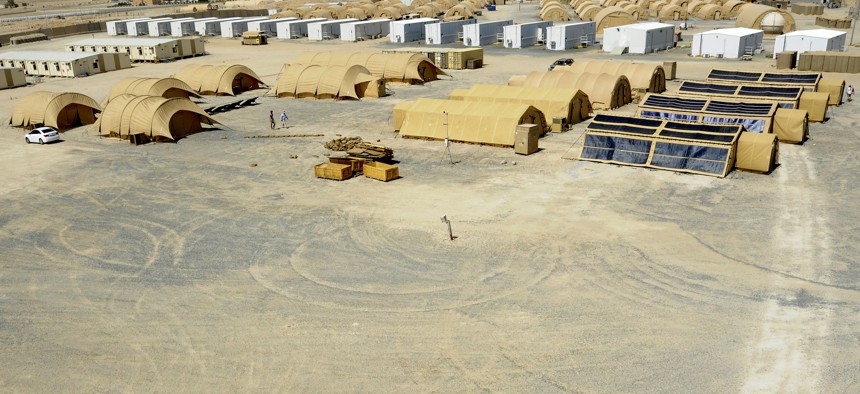
Tents being used in the research project illustrate the different technologies being used at an undisclosed location, Aug. 15, 2013. U.S. Air Force photo by Master Sgt. Christopher A. Campbell
The Military Is Pouring Money into Smart Fabrics, But There's a Holdup
A lead researcher explains why high-tech cloth could help the Pentagon with everything from solar-powered tents to sniper-detecting uniforms.
The Pentagon is funding high-tech textiles that could that could make soldiers’ uniforms part of a network of sensors, and researchers at the University of Central Florida are among the groups who want to create them.
Earlier this month, the Defense Department announced plans to contribute $75 million to a textile technology research effort, hosted at the Massachusetts Institute of Technology, and led by 89 industry and academic partners including UCF.
Nextgov spoke with Ayman Abouraddy, one of the UCF scientists working on one of that program's flagship projects, about why hi-tech fabrics are the next big thing in wearables. This conversation has been edited for length and clarity.
NG: What project are you working on for the new high-tech textiles consortium, partially funded by the Pentagon?
AA: We’re running one of three flagship projects. We’re working with The North Face on making tents that capture solar energy to make its users energy-autonomous. The North Face will be the major industrial collaborator on that program.
NG: What are the coolest projects you’re working on, or have worked on in your career?
AA: My group is on the interface between material science and optics. One of the DARPA[-funded] programs is how to develop systems to look around a corner. With DARPA, we’re making optical fibers for ocean communication — fibers that are less than 1 millimeter in diameter, as strong as steel but as light as water.
The breakthrough we had around 2003-2004 was we’re able to use three classes of materials in a fiber. One is a semiconductor, one is a conductor, one is an insulator. These are the three materials you need to build any electronic device. As a result, we started to create electronic devices inside the fiber, extending the whole length of the fiber.
One thing we were doing for the Army at the time was to incorporate those fibers into soldiers’ clothing. As a result, the clothing becomes sensitive to light over its whole area, so if a sniper gun were aimed at a solder, even if it were an infrared beam so it’s not visible, the fibers embedded in the fabric deliver an electronic signal saying, “This surface is being interrogated by a laser.”
Similar functionality could be extended to thermal sensing. Temperature would allow one to form a temperature map of the body, and as a result be able to know if a soldier is hurt, or incapacitated, or even know what type of injury even if a soldier can’t report it.
What we’re getting is electronic functionality spread over a full surface. Typically, wearable electronics are just small devices that are stuck on the fabric, so they’re localized — which misses the point of a fabric, where you have a large area that’s in contact with the body and the environment. That’s prime real estate to do sensing, to do energy capture from the environment.
NG: Is any of that on the market?
AA: It’s not on the market. The Army has done a battlefield simulation with these types of fibers and has been successful. The problem is the textile industry has a lot of inertia, and it’s quite costly to do a full run of manufacturing with new ideas.



